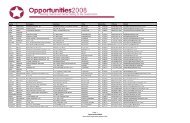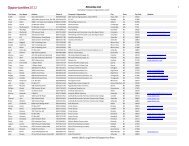Capital Opportunities for Small Businesses - sbtdc
Capital Opportunities for Small Businesses - sbtdc
Capital Opportunities for Small Businesses - sbtdc
Create successful ePaper yourself
Turn your PDF publications into a flip-book with our unique Google optimized e-Paper software.
C A P I T A L O P P O R T U N I T I E S F O R SMA L L B U S I N E S S E S<br />
financing. The proceeds from the loan can either be used as a source of direct financing or as collateral to<br />
secure a credit line.<br />
Growth Phase<br />
Internal Financing<br />
Cash Management Tools<br />
Effective cash management of a business is one of the best ways to raise capital, and it also helps avoid paying<br />
interest on unnecessary external debt. Since short-term cash flow needs are vital to company operations,<br />
available cash flow management techniques must be maximized. <strong>Small</strong> business banking services are<br />
traditionally oriented around deposits and loans, with most services tied to checking accounts. However,<br />
specialized services once used primarily by larger companies are now available to smaller businesses. The<br />
following services can be used as part of an efficient cash management program:<br />
a. Lockbox: An integral part of a profitable business is a fast, efficient accounts receivable process. A lockbox<br />
is a post office box maintained by the bank to receive payments made to a business. The bank empties the<br />
lockbox frequently and immediately deposits checks into your account. The advantage is that funds become<br />
available much faster than if they are first sent to the place of business.<br />
b. b. Controlled Disbursement Account: This tool enables the business to make timely payments while<br />
maintaining the maximum earning power of funds. With a controlled disbursement account, the business<br />
receives daily notification of the checks that will clear the account that day. Only the amount needed to<br />
cover those checks is transferred to the checking account, ensuring that no idle cash remains in the account.<br />
c. Sweep Account: A sweep account is an automatic system to move excess money into an interest-bearing<br />
account every night. After all debits and credits are posted to the checking account at the end of the day,<br />
funds in that account are automatically swept into a money market or savings account.<br />
Accounts Receivable Management<br />
Effective short-term cash flow management is vital to a company’s operations. Short-term financing needs are<br />
decreased when cash flow is maximized through matching accounts receivable with accounts payable. This is<br />
done by carefully negotiating and managing credit terms with customers and suppliers. Periods where payables<br />
exceed receivables must be handled through short-term financing such as a line of credit. If the business itself<br />
delays sending bills, the result is a longer period be<strong>for</strong>e payment is received. The use of that cash to cover<br />
payables or <strong>for</strong> investment is lost over that period. The same is true when the collection cycle is lengthened as a<br />
result of a failure of customers to pay according to the credit terms. Consider using discounts to encourage<br />
timely customer payment.<br />
Inventory Control<br />
The less excess inventory carried, the greater the availability of funds <strong>for</strong> interest-bearing accounts or working<br />
capital purposes. Excess inventory lowers a company’s profitability due to the money spent to produce or<br />
purchase the idle goods that take up warehouse space and increase insurance costs. The goal of avoiding<br />
excess inventory must be balanced with a company’s ability to consolidate inventory purchases to take<br />
15









